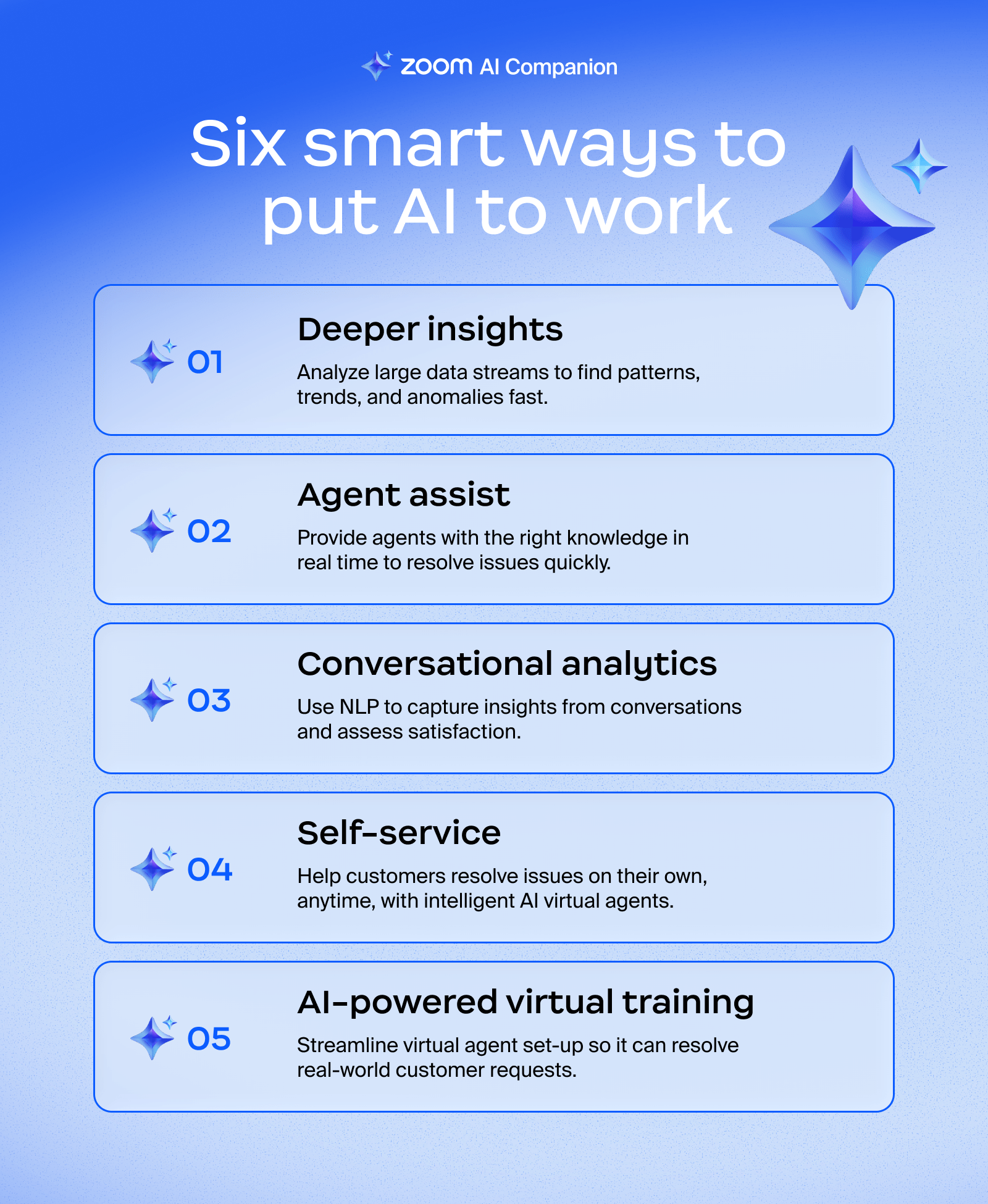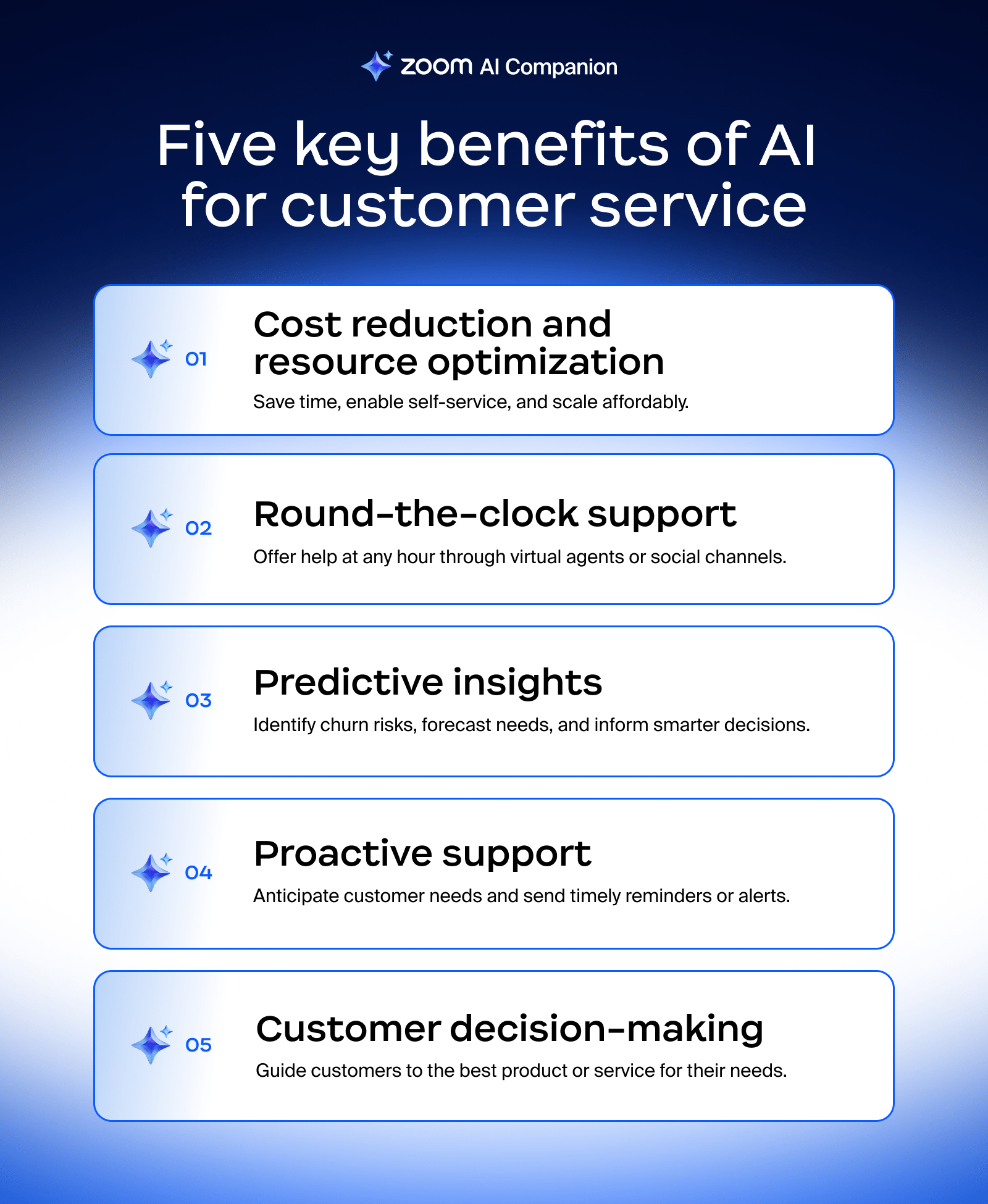
From frustration to connection: The new era of agentic AI self-service
Discover how AI self-service and agentic AI revolutionize customer experience. Explore solutions like our next-generation Zoom Virtual Agent.
Updated on August 29, 2025
Published on June 28, 2023


To improve CX, businesses can’t rely on chatbots alone and must implement AI-powered technology that truly augments their customer service.
Chatbots have become practically synonymous with artificial intelligence (AI) for customer service. Chatbots that leverage AI can augment a customer service team’s capabilities by answering routine questions, providing 24/7 access to information, enabling multilingual support, and enhancing overall customer experiences.
But the options to use AI for customer service extend far beyond a traditional chatbot. Businesses can implement AI-powered technology in many other ways throughout their customer service operations, helping to evolve good customer service into great customer service.
AI-powered customer service improves every part of an operation, delivering frictionless experiences for both customers and agents while driving more efficient, cost-effective workflows. Rather than replacing humans, AI helps elevate them — taking care of routine work so agents can spend more time on strategic, creative, and human-centered interactions.
Here are some examples of how customer service support can benefit from using AI:
1. Deeper insights
AI can analyze large data streams quickly, much faster than any human could. Furthermore, these technologies can identify patterns, trends, and anomalies that may go undetected by people overwhelmed by the sheer volume of data that a customer service or contact center generates. AI can make data analysis much more time and cost-effective, with more accurate and thorough insights that the entire business can benefit from.
2. Agent assist
AI can help agents do their jobs more effectively by surfacing the right knowledge exactly when they need it. With enhanced technology such as Retrieval-Augmented Generation (RAG), agent assist systems can analyze customer service interactions in real time, quickly retrieve the most relevant information from vast knowledge bases, and pull it up to support agents in real time. This not only accelerates issue resolution but also reduces cognitive load, helping agents, especially those new to the role, feel more competent and confident on the job.
As a Metrigy report, commissioned by Zoom, found: 64% of companies using agent assist saw a 28% reduction in average handle time, and 42% saw a 29% drop in agent attrition.
3. Conversational analytics
Conversational analytics uses natural language processing (NLP) to capture data from customer interactions, including interactions with virtual agents. By transcribing voice conversations and applying sentiment analysis, businesses gain deeper visibility into how customers feel about their experience and their overall impression of the brand. These insights not only highlight levels of satisfaction but also help leaders identify pain points, evaluate agent performance, and spot areas where additional coaching or retraining may be needed.
4. Self-service
Self-service is growing. According to our Zoom-commissioned Morning Consult research, about 80% of those who have had previous success using chatbots or voicebots say that they always, often, or sometimes prefer support that doesn’t involve a human.
Although traditional chatbots can give customers a self-service option to some degree, AI can now intelligently help customers resolve issues on their own. New innovations in agentic AI mean chatbots can have contextual understanding of human behavior patterns, remember interactions, reason, and take action, with less need for a human agent’s help.
5. AI-powered virtual training
AI can streamline virtual agent set-up by automatically taking in FAQs, documents, and knowledge bases to build conversation flows. It can then simulate customer interactions, test responses, and optimize performance before going live, ensuring the virtual agent is ready to resolve real-world customer requests.

While automation can optimize processes, keep in mind that AI can also enhance the overall customer experience, sometimes much more than human agents using traditional processes alone. Here are some examples of what AI can do:
1. Personalizes user experiences
AI can analyze data quickly and tailor responses to individual customers. For example, AI can identify a customer’s location and make offers for products or services available locally. AI can also analyze an individual customer’s data for an even greater degree of personalization.
2. Improves human interactions with customers
AI also helps human customer service representatives do their jobs more effectively. AI can summarize interactions during a handoff to help agents get up to speed quickly and solve issues faster. Furthermore, when AI virtual agents handle most queries, agents can focus on improving their skills in order to provide excellent customer service experiences.
AI also benefits agents, helping to set them up for success and create a less stressful work environment. It can accomplish the following:
1. Prevents burnout
A customer agent’s job can be stressful with long queues of customers waiting for their assistance and a ticking clock that records their resolution time. Too many stressful hours lead to burnout. AI can give customers self-service options, shortening queues and helping to avoid agent burnout.
2. Streamlines workflows
AI for customer service simplifies providing the best possible support experience in several ways, including:
AI brings many benefits to customer service, ultimately increasing efficiency and productivity and improving customer experiences. With 3 in 4 consumers reporting that they discuss positive or negative support experiences with others, AI-powered customer service that helps provide positive interactions is becoming a key differentiator for companies. As a result, businesses are benefiting from the following AI customer service advantages:
1. Cost reduction and resource optimization
Implementing AI saves time, enables self-service, and reduces the demand for agents to work overtime, all while providing excellent customer service. Plus, scaling capabilities with AI technology is more cost-effective than hiring new agents. Fewer jobs will be lost in the long run because if demand decreases due to an economic downturn, a business can scale back AI and avoid the need to lay off employees.
2. Round-the-clock support
Customers have questions and need assistance at all hours of the day; they don’t want to wait until a business opens to get help. AI can work around the clock and is accessible via phone calls, website chatbots, social media, or apps like Facebook Messenger. Customers can get the answers when it’s most convenient for them. AI for customer service also helps agents avoid a 9 a.m. spike in inquiries.
3. Predictive insights
Businesses use AI to understand the status of things: the project update, guidance through a process, and where items are in manufacturing or shipping. But beyond descriptive analytics, AI can also provide predictive insights and should be part of a business’s overall CX strategy. For example, AI can move beyond surface-level reporting to uncover hidden patterns in customer data, highlight early signals of churn, and surface likely outcomes. This helps leaders make faster, smarter decisions that improve performance and customer satisfaction.
4. Proactive support
With AI, customer service teams can shift their response strategy from reactive to proactive. In fact, AI can provide insights into the information customers may need based on the products they’ve purchased or the services they’ve received. This data can trigger reminders for customers to take action without them having to contact customer support. For example, AI can send an alert to tell a customer they may run out of a product soon, and it’s time to reorder.
These little moments show a customer they are cared for and can help transform customer interactions from a mediocre to a memorable experience.
5. Customer decision-making
Consumers are familiar with traditional AI-powered virtual agents, which answer their questions and help them perform simple tasks. As AI platforms’ capabilities have expanded, virtual agents can now solve more complex queries. They can also guide customers through decision-making to help them make purchases they’ll be most happy with or choose the best service offering for their needs.

AI customer service platforms vary in price, but many are delivered through the Software as a Service (SaaS) model, charging a monthly fee rather than requiring businesses to make a CapEx.
Of course, each business needs to consider its budget and the pain points it plans to solve with AI. But remember to factor in the total cost of ownership for customer support and weigh the costs of the AI solution against other options, including hiring more employees. AI’s cost will likely compare favorably.
Getting started with AI for customer service requires careful planning. First, you need to determine the tasks that AI will perform for your business and the data you need to train your platform, such as integration with your knowledge base or your customer service management system.
Working with the right AI customer service platform provider can make the process easier as you’ll get the guidance and support you need for a successful implementation.
Zoom Virtual Agent is a great step towards AI-powered customer support. A self-service solution that’s powered by an agentic AI framework to help you deliver always-on, proactive care, Zoom Virtual Agent doesn’t just respond, but acts with purpose to solve your customers’ needs. Zoom Virtual Agent also integrates with various CRM, ticketing systems, and CCaaS platforms to help you create an intelligent, connected, and unified communications environment.
Contact an expert today to explore all the ways AI can level-up your customer service operation.